The constellations in tonight’s sky host many familiar star patterns. For northern observers, early spring is the best time of the year to see Ursa Major (the Great Bear), Canes Venatici (the Hunting Dogs), Leo (the Lion), Leo Minor (the Smaller Lion), and Lynx. These constellations appear high overhead in the evening. The Big Dipper, the Sickle of Leo, the Spring Triangle, and the Diamond of Virgo are the most prominent star patterns visible around 10 pm.
Observers in the southern hemisphere can catch Centaurus (the Centaur), Crux (the Southern Cross), and Vela (the Sails) high above the horizon at this time of the year. Centaurus and Crux host some of the brightest stars in the sky. Centaurus hosts Alpha and Beta Centauri, the third and 11th brightest stars in the sky. The brightest stars of Crux form the Southern Cross, the most familiar asterism in the far southern sky.
The night sky tonight looks different depending on the location. The constellation maps below show the sky at around 10 pm in the mid-northern, equatorial, and mid-southern latitudes.
Northern hemisphere
The most prominent constellation appearing high overhead around 10 pm is Ursa Major (the Great Bear). The constellation’s most recognizable part, the Big Dipper, stands out in the evening sky. The asterism can be used to find the brightest stars in the constellations Boötes (the Herdsman), Virgo (the Maiden), Canes Venatici (the Hunting Dogs), Leo (the Lion), Auriga (the Charioteer), and Gemini (the Twins). It is also commonly used to find Polaris (the North Star), the brightest star in Ursa Minor (the Little Bear) and the nearest visible star to the north celestial pole.
Polaris can be found by extending a line from Merak through Dubhe, the outer stars of the Big Dipper’s bowl. Megrez and Phecda, the inner stars of the bowl, point toward Regulus, the brightest star in Leo, in the opposite direction.
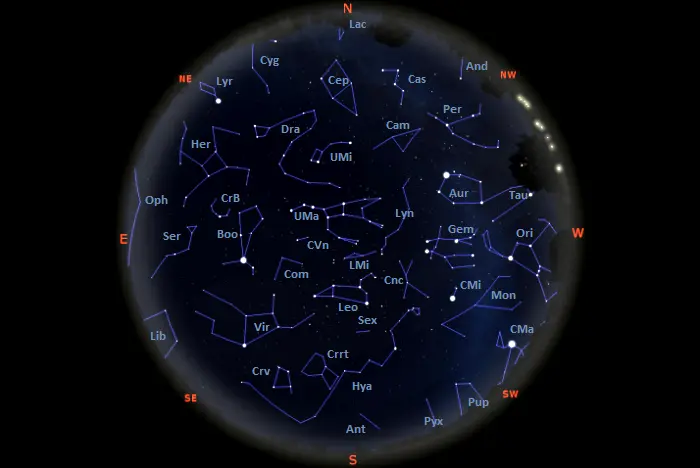
Tonight’s sky as seen from the mid-northern latitudes, image: Stellarium
Arcturus and Spica, the luminaries of Boötes and Virgo, are found by following the curved imaginary line extended from the Big Dipper’s handle. Capella, the brightest star in Auriga, lies on the imaginary line extended from the Great Bear’s back, while Pollux and Castor, the luminaries of Gemini, can be located by drawing a line through the Dipper’s bowl.
The fainter constellations Lynx, Leo Minor (the Little Lion), and Canes Venatici (the Hunting Dogs) appear closer to the Great Bear. Cor Caroli and Chara, the brightest stars of Canes Venatici appear roughly parallel to Alkaid and Mizar, the stars at the end of the Big Dipper’s handle. Leo Minor may be spotted between the Great Bear’s feet and the head of the Lion on a very clear, dark night, while Lynx appears between the Bear’s head and front feet on the one side and the brightest stars of Auriga and Gemini on the other.
Eastern sky
The constellations rising in the east in the evening include Boötes (the Herdsman), Serpens (the Serpent), Hercules, Corona Borealis (the Northern Crown), and Ophiuchus (the Serpent Bearer). Virgo (the Maiden) and Libra (the Scales) rise in the southeastern sky, and Lyra (the Lyre) appears in the northeast.
The dominant pattern of Boötes is the Kite, a relatively bright asterism formed by the constellation’s brightest stars. Arcturus, the brightest star in Boötes and in the northern celestial hemisphere, appears at the base of the Kite. The rest of the asterism stretches between the handle of the Big Dipper and the Northern Crown.
Arcturus is the brightest star in the Diamond of Virgo (the Great Diamond), as well as in the Spring Triangle. The Spring Triangle is formed by Arcturus with Spica in Virgo and Regulus in Leo, while the Great Diamond is formed by Arcturus and Spica with Denebola in Leo and Cor Caroli in Canes Venatici. Both asterisms are prominent in the evening sky throughout the spring months.
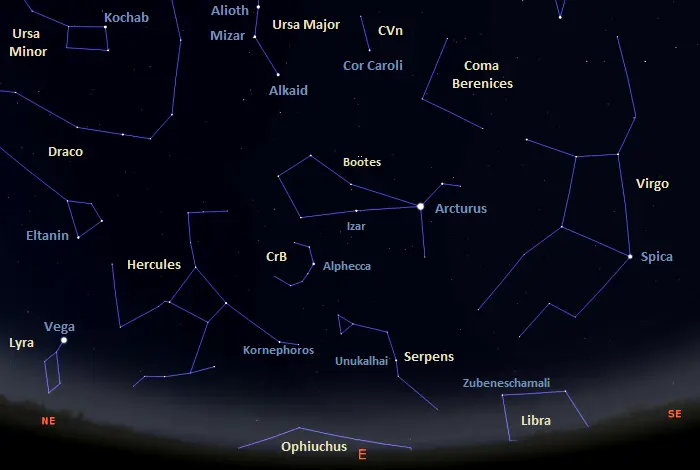
Eastern sky in the northern hemisphere, image: Stellarium
Spica, the brightest star in Virgo, appears at the base of the Y of Virgo. The rest of the Y asterism extends in the direction of Coma Berenices (Berenice’s Hair) and Leo.
Representing the crown of Ariadne in Greek mythology, the Northern Crown is one of the most distinctive northern asterisms. Easily visible on a clear night, it sits between the Kite of Boötes and the Keystone in Hercules. Both the Keystone and the Northern Crown appear in the region between the bright Vega in Lyra and Arcturus in Boötes.
Vega, the brightest star in Lyra, appears low in the northeast around 10 pm. It is the fifth brightest star in the sky and the second brightest star in the northern celestial hemisphere, after Arcturus.
Northern sky
Cassiopeia (the Queen) and Cepheus (the King) are the most prominent constellations in the northern evening sky. Cassiopeia’s brightest stars form a W asterism that can be used to find the neighbouring Cepheus and Perseus. A line drawn from Schedar through Caph points in the direction of Alderamin, the brightest star in Cepheus.
Gamma and Delta Cassiopeiae (Ruchbah), the central and bottom left stars of the W, point towards Perseus in the northwestern sky. The supergiant Mirfak, the brightest star in Perseus, is the brightest member of the Alpha Persei Cluster, an open cluster visible to the unaided eye.
Draco (the Dragon), one of the largest northern constellations, occupies much of the northern and northeastern sky around 10 pm. The head of the celestial Dragon is found by extending a line through the wings of the Swan (Cygnus), and the Dragon’s body and tail wind around the Little Dipper’s bowl.
The Little Dipper is the most visible part of the constellation Ursa Minor (the Smaller Bear). Unlike the Big Dipper, the Little Dipper is not easily spotted from areas with too much light pollution. Polaris and the outer stars of the Dipper’s bowl are easily visible, but the middle stars are quite faint and require good conditions.
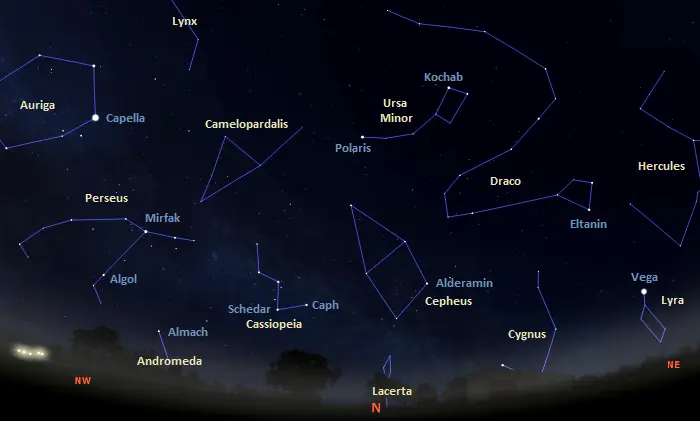
Northern sky in the northern hemisphere, image: Stellarium
Western sky
The constellations of the Winter Circle set in the west in the evening. Sirius and Rigel, the brightest stars of Canis Major (the Great Dog) and Orion (the Hunter), may or may not be visible around 10 pm, depending on the location and geography.
The hourglass figure of Orion is partly visible above the western horizon. The stars of Orion’s Belt appear almost parallel to the horizon and point towards Sirius, the brightest star in the sky. In the other direction, they point towards Aldebaran, the luminary of Taurus (the Bull). Aldebaran and the fainter Ain mark the Bull’s eyes.
The constellations Auriga (the Charioteer) and Gemini (the Twins) appear higher in the sky. Pollux and Castor, the stars that mark the heads of the mythical Twins, appear directly above Orion, and the hexagon of Auriga lies above Taurus in the evening.
The faint constellation Monoceros (the Unicorn) may be spotted within the Winter Triangle on a clear night. The stars of the Winter Triangle – Sirius in Canis Major, Procyon in Canis Minor, and Betelgeuse in Orion – keep setting earlier as the spring season progresses.
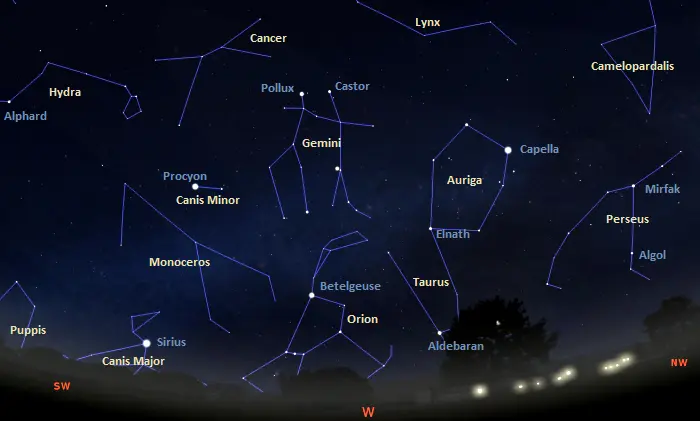
Western sky in the northern hemisphere, image: Stellarium
Southern sky
Hydra (the Water Snake), the largest of the 88 constellations, stretches from the southeastern to the southwestern sky in the evening. Despite its size, the constellation is not prominent because most of its stars are relatively faint. Alphard, the brightest star in Hydra, is the only bright star southwest of Regulus and the Sickle of Leo.
The constellation figure of Leo appears almost overhead in the evening. The celestial Lion is easy to identify because it looks like the animal it represents. Its head and mane are outlined by the stars of the Sickle of Leo, the bright Regulus marks its heart, and Denebola its tail.
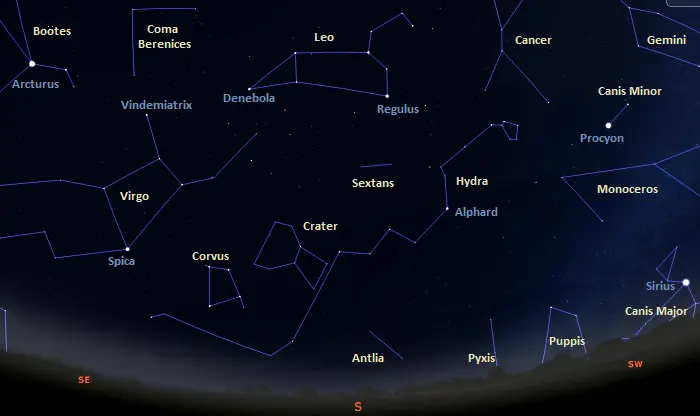
Southern sky from the northern hemisphere, image: Stellarium
Denebola in Leo and Vindemiatrix in Virgo can be used to find the Virgo Cluster of galaxies, whose centre appears almost exactly halfway between the two bright stars.
Vindemiatrix is part of the Y of Virgo, a conspicuous asterism that appears high in the southeast in the evening. Spica, Virgo’s brightest star, appears at the base of the crooked Y pattern.
The brightest stars of Corvus (the Crow) form an asterism known as the Sail or Spica’s Spanker. The northern side of the asterism points towards Spica.
Equatorial latitudes
Virgo (the Maiden) and Leo (the Lion) are the most prominent constellations high overhead for observers in the equatorial latitudes. The two zodiac constellations are easy to recognize because their stars form conspicuous patterns.
An asterism known as the Sickle of Leo forms the Lion’s head and mane, while the bright stars of Virgo form a crooked Y, called the Y of Virgo. Regulus and Spica, the brightest stars in Leo and Virgo, appear at the bases of the two asterisms.
Both stars can be found using the Big Dipper. The arc of the Big Dipper’s handle, formed by Alioth, Mizar and Alkaid, leads first to Arcturus and then to Spica. A line extended from the inner stars of the Dipper’s bowl points in the general direction of the Sickle.
The fainter Hydra (the Water Snake) also appears high overhead in the evening. Even though it is the largest constellation in the sky, Hydra does not really stand out. Its brightest star, the orange giant Alphard, can be found southwest of the Sickle of Leo.
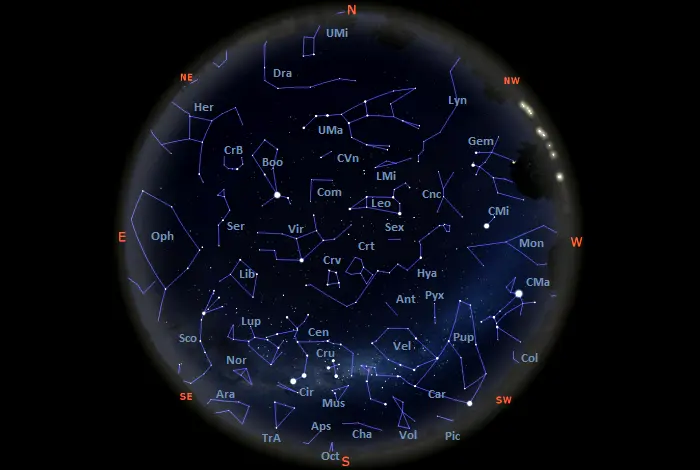
Tonight’s sky as seen from equatorial latitudes, image: Stellarium
Northern sky
Ursa Major (the Great Bear) is the most conspicuous constellation above the northern horizon in the evening. The Big Dipper appears upside down. Its handle points towards the bright Arcturus, the brightest star in Boötes (the Herdsman). The inner stars of the bowl point in the direction of the Sickle of Leo, an asterism that outlines the Lion’s head, and a line drawn through the bowl leads to Pollux and Castor, the brightest stars in the constellation Gemini (the Twins).
Merak and Dubhe, the outer stars of the Big Dipper’s bowl, point towards Polaris, the North Star, which is mostly invisible from locations close to the equator. Polaris is part of the Little Dipper, which is partly visible low in the northern sky.
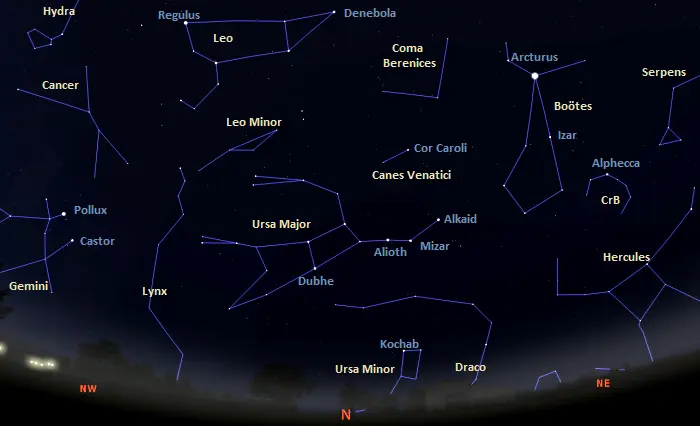
Northern sky from equatorial latitudes, image: Stellarium
Eastern sky
The large polygon of Ophiuchus (the Serpent Bearer) rises in the east around 10 pm. The Serpent Bearer is the 11th largest constellation in the sky and takes up much of the sky above the eastern horizon in the evening. Ophiuchus splits the constellation Serpens (the Serpent) in two: Serpens Caput (the Serpent’s Head) and Serpens Cauda (the Serpent’s Tail).
The constellations Boötes (the Herdsman), Corona Borealis (the Northern Crown) and Hercules appear in the northeastern sky around 10 pm. Boötes is the highest in the sky. Arcturus, its brightest star, appears at the base of the Kite, a relatively bright asterism that appears upside down in the northeastern sky.
The Kite appears close to the Northern Crown (Corona Borealis), a distinctive semi-circle of stars that represents Ariadne’s crown in Greek mythology. The constellation’s brightest star, Alphecca, marks the jewel in the crown.
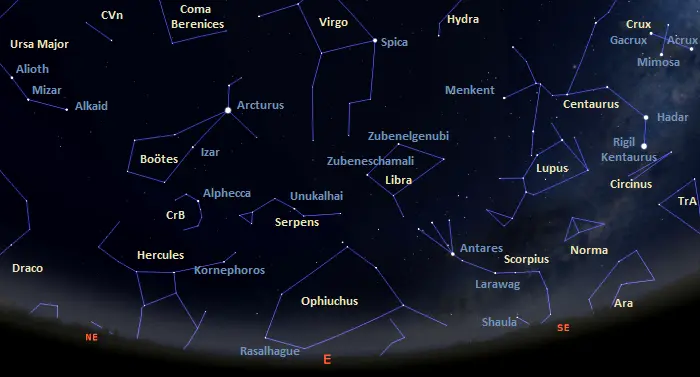
Eastern sky from equatorial latitudes, image: Stellarium
Hercules is the fifth largest of the 88 constellations, but it is not particularly conspicuous. The Keystone, a four-sided asterism that outlines the torso of Hercules, is easily visible on a clear night.
The zodiac constellations Scorpius (the Scorpion) and Libra (the Scales) appear to the southeast. The Fish Hook of Scorpius may not be fully visible around 10 pm, but the scorpion’s claws appear higher in the sky. The red supergiant Antares, the brightest star in Scorpius, connects the two asterisms and marks the Scorpion’s heart. Shining at magnitude +0.6 – 1.6, the variable supergiant is on average the 15th brightest star in the sky.
Libra appears as the extended claws of the Scorpion. Its brightest stars, Zubeneschamali and Zubenelgenubi, shine at third magnitude and do not stand out in the sky next to the brighter stars of Scorpius.
Western sky
The faint Monoceros (the Unicorn) appears directly west, in the region between the brighter Canis Major (the Great Dog), Canis Minor (the Lesser Dog), and Gemini (the Twins). As the season progresses, these constellations will keep setting earlier in the western sky in the evening.
Canis Major and Canis Minor host Sirius and Procyon, the brightest and eighth brightest stars in the sky. Both these stars are among our nearest neighbours. Sirius lies 8.60 light-years away and Procyon, 11.46 light-years away.
Pollux and Castor, the brightest stars in Gemini, mark the heads of the celestial Twins. They appear in the northwestern sky in the evening. The brighter Pollux shines at magnitude 1.14 from a distance of 33.78 light-years, while Castor has an apparent magnitude of 1.58 and lies around 51 light-years away. Pollux is a single K-type giant, and Castor is part of a sextuple star system.
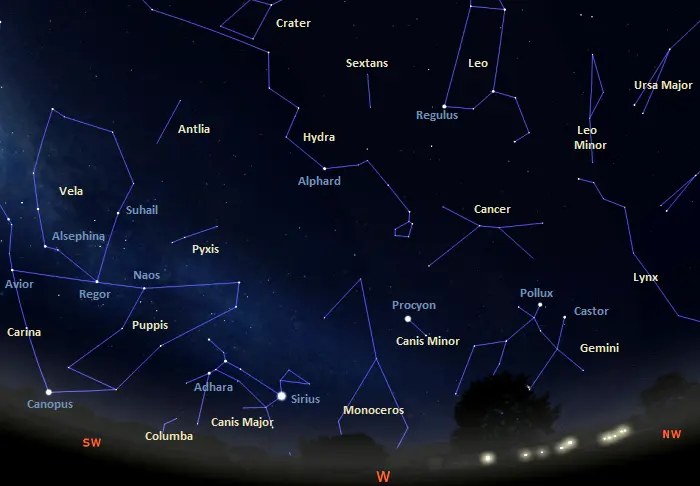
Western sky from equatorial latitudes, image: Stellarium
Southern sky
The constellation Crux is conspicuous above the southern horizon. Its brightest part, the Southern Cross, appears almost directly south. The Southern Cross is one of three diamond-shaped asterisms visible in the evening. The larger but slightly fainter False Cross appears in the southwestern sky. It is formed by Alsephina, Avior, Markeb and Aspidiske in the constellations Carina and Vela. The Diamond Cross, formed by Miaplacidus with three fainter stars in Carina, appears between the two brighter asterisms.
The real Southern Cross is easy to identify because it has a fifth star disrupting its diamond pattern and because it appears next to the Southern Pointers, Rigil Kentaurus (Alpha Centauri) and Hadar (Beta Centauri). The two bright Centaurus stars point towards Gacrux, the star at the top of the Cross. A line through the longer axis of the Southern Cross points towards Musca (the Fly).
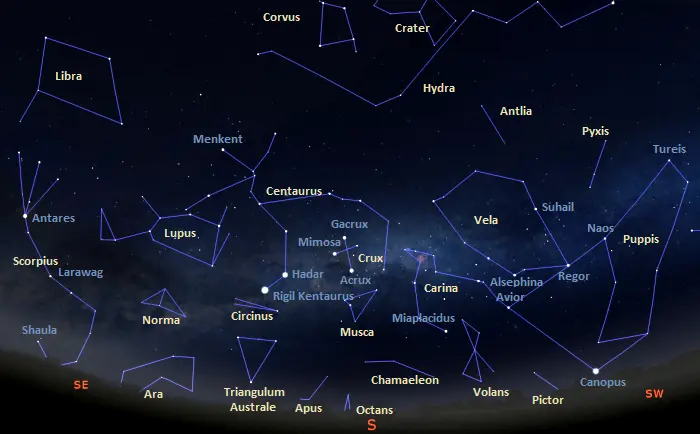
Southern sky from equatorial latitudes, image: Stellarium
Alpha and Beta Centauri appear in the leg of the celestial Centaur. The Centaur’s head, marked by the orange giant Menkent, appears high above the southeastern horizon.
The fainter Lupus (the Wolf) can be made out between Centaurus and Scorpius, and the conspicuous triangle of Triangulum Australe (the Southern Triangle) is found below Alpha and Beta Centauri.
Carina (the Keel), Vela (the Sails) and Puppis (the Stern or Poop Deck) dominate the southwestern sky. The three constellations formed Argo Navis, the largest constellation in the sky until the 18th century. The constellation represented the Ship Argo, on which Jason and the Argonauts sailed to Colchis to retrieve the Golden Fleece.
Canopus, the brightest star in Carina, is the second brightest star in the sky, after Sirius. It lies low above the southwestern horizon in the evening.
Southern hemisphere
The constellations that appear high overhead in the evening for observers in the southern hemisphere are Centaurus (the Centaur), Crux (the Southern Cross), Hydra (the Water Snake), and Vela (the Sails).
With 10 stars brighter than magnitude 3.0, Centaurus is one of the brightest constellations in the sky. It is home to Alpha and Beta Centauri (Rigil Kentaurus and Hadar), the third and 11th brightest stars in the sky. Centaurus is also one of the largest constellations, stretching across 1,060 square degrees of the southern sky. The luminaries of Centaurus point toward Gacrux, the star at the top of the Southern Cross in the constellation Crux.
Crux, the smallest of the 88 constellations, is also one of the best-known in the southern hemisphere. Its brightest stars – Acrux, Mimosa, Gacrux, Imai, and Ginan – form the Southern Cross, an asterism commonly used to find true south.
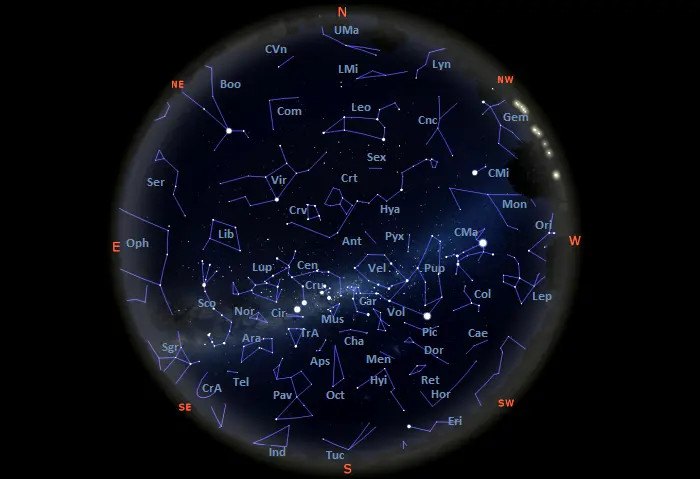
Tonight’s sky as seen from the southern hemisphere, image: Stellarium
Hydra, the largest constellation in the sky, is not as easy to identify because its stars are relatively inconspicuous. Alphard, the constellation’s brightest star, shines at second magnitude and appears southwest of Regulus in Leo.
Representing the Sails of Argo Navis (the Ship Argo), Vela used to form the larger constellation Argo Navis with the neighbouring Carina (the Keel) and Puppis (the Stern). The constellation’s brightest stars – Regor (Gamma2 Velorum), Alsephina (Delta Velorum), Suhail (Lambda Velorum), and Markeb (Kappa Velorum), shine at second magnitude.
Alsephina and Markeb form the False Cross with Avior and Aspidiske in Carina. The diamond-shaped star pattern is commonly mistaken for the brighter and smaller Southern Cross.
Northern sky
The constellation figure of Leo (the Lion) appears upside down above the northern horizon in the evening. Regulus, Leo’s brightest star, marks the base of the Sickle, an asterism that represents the Lion’s head. The bright Denebola marks the Lion’s tail.
Leo’s zodiac neighbour Virgo (the Maiden) appears higher in the northeastern sky. Spica, the brightest star in Virgo, appears at the base of a crooked Y asterism that dominates the constellation.
Arcturus, the luminary of Boötes (the Herdsman) and the brightest star in the northern celestial hemisphere, appears lower in the northeastern sky.
Arcturus, Spica and Regulus form an asterism known as the Spring Triangle in the northern hemisphere. Arcturus and Spica also form the Great Diamond (the Diamond of Virgo) with Denebola in Leo and the fainter Cor Caroli, the brightest star of Canes Venatici (the Hunting Dogs). The faint constellation Coma Berenices (Berenice’s Hair), the home of the Coma Star Cluster, appears within the Great Diamond.
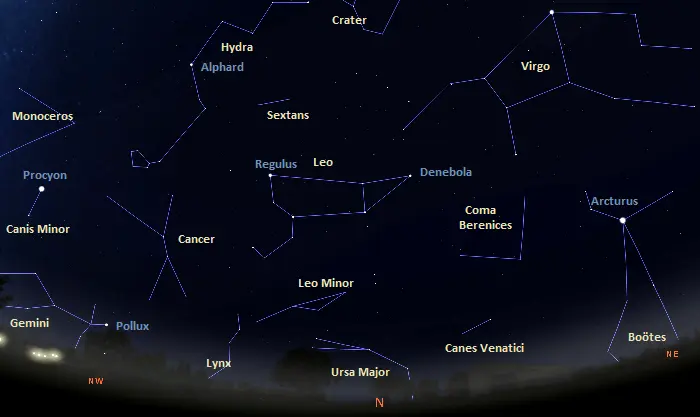
Northern sky in the southern hemisphere, image: Stellarium
Eastern sky
The zodiac constellations Virgo (the Maiden), Libra (the Scales), Scorpius (the Scorpion), and Sagittarius (the Archer) stretch from the northeastern to the southeastern sky around 10 pm.
Libra and Scorpius appear high above the eastern horizon. The brightest stars of Libra appear as the extended claws of the celestial Scorpion. The constellation figure of Lupus (the Wolf) appears upside down above Scorpius.
The Fish Hook of Scorpius, an asterism that curves from the bright red supergiant Antares at the Scorpion’s heart to Shaula and Lesath at the stinger, dominates the southeastern sky.
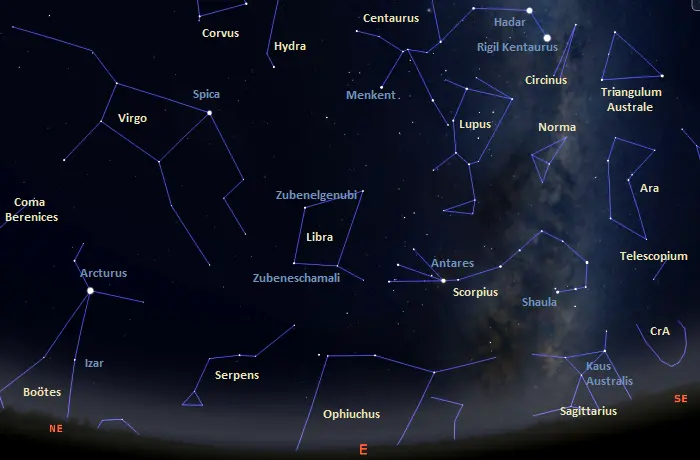
Eastern sky in the southern hemisphere, image: Stellarium
The Teapot asterism, the identifying feature of Sagittarius (the Archer), is only partly visible above the southeastern horizon. The star pattern lies in a rich field of the Milky Way and can be used to find the many bright deep sky objects that appear in this region of the sky, including the Lagoon Nebula (M8), the Trifid Nebula (M20), and the Omega Nebula (M17).
The polygon of Ophiuchus (the Serpent Bearer) rises in the east but is not fully visible around 10 pm. The three bright stars at the base of the polygon form a relatively straight line with Unukalhai, the brightest star in Serpens (the Serpent). The constellation Ophiuchus splits Serpens into two parts, Serpens Caput (the Serpent’s Head) and Serpens Cauda (the Serpent’s Tail). Unukalhai appears in the Serpent’s neck.
Western sky
Sirius, the brightest star in the sky, appears almost directly west in the evening. Adhara, the second brightest star in Canis Major (the Great Dog) forms a triangle with the fainter Wezen and Aludra that can be used to identify the constellation Puppis (the Stern of the Ship Argo).
Canopus, the second brightest star in the sky and the luminary of Carina (the Keel), appears high in the southwestern sky. It can be used to find the faint constellations Pictor (the Easel) and Dorado (the Dolphinfish).
The constellation figure of Orion (the Hunter) is mostly invisible by 10 pm. Orion’s Belt and the blue supergiant Rigel may be spotted setting in the west earlier in the evening. Rigel and Saiph can be used to find the less conspicuous constellation Lepus (the Hare). The fainter Columba (the Dove) appears in the region between Lepus and Canopus.
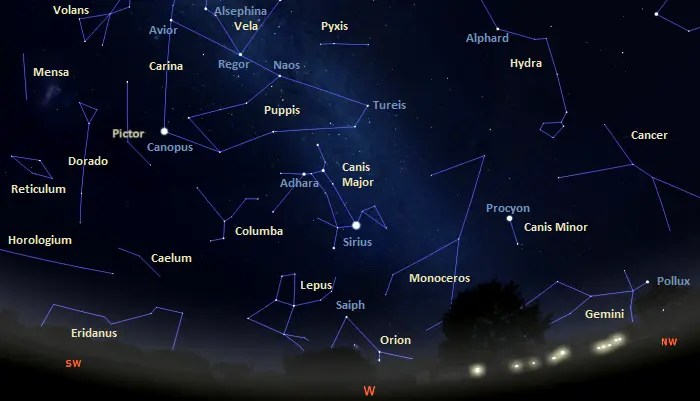
Western sky in the southern hemisphere, image: Stellarium
The bright stars of Gemini (the Twins) and Canis Minor (the Lesser Dog) appear in the northwestern sky. Pollux and Castor, the brightest stars in Gemini, appear low above the northwestern horizon.
Procyon, the eighth brightest star in the sky, is the only bright star in Canis Minor. It can be used to find the faint constellation Monoceros (the Unicorn), which lies in the region between Procyon, Sirius, and the bright stars of Orion.
Southern sky
The southern sky is populated by many small, faint constellations that are not easy to spot from light-polluted areas. Tucana (the Toucan) appears directly south. It is one of the four Southern Birds constellations, along with Grus (the Crane), Phoenix, and Pavo (the Peacock). Pavo appears higher in the sky. Its brightest star, Peacock (Alpha Pavonis), is one of the bright stars selected for use in the field of celestial navigation.
Tucana and the neighbouring Hydrus (the Lesser Water Snake) host the Small Magellanic Cloud (SMC), one of the nearest galaxies to the Milky Way. The brighter Large Magellanic Cloud (LMC) is found in Dorado (the Dolphinfish) and Mensa (Table Mountain).
Triangulum Australe (the Southern Triangle) is prominent above Pavo and below Alpha and Beta Centauri in the evening. The constellation’s three brightest stars form a triangle that gives the constellation its name. Atria (Alpha Trianguli Australis) points in the direction of Pavo.
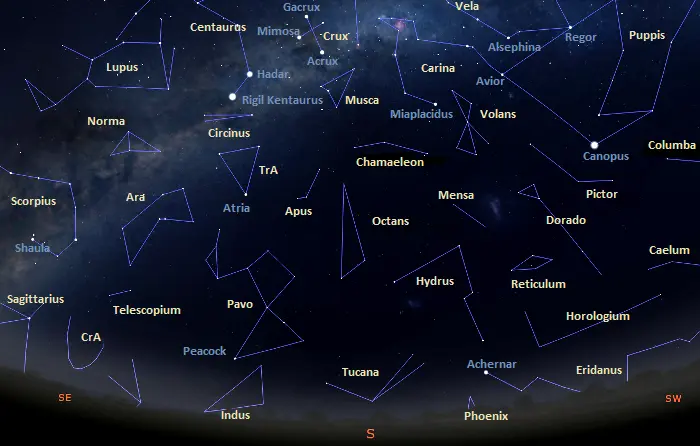
Southern sky in the southern hemisphere, image: Stellarium
Eridanus (the River) hosts the only first-magnitude star visible above the southern horizon in the evening. Achernar (Alpha Eridani) is the ninth brightest star in the sky. It is slightly brighter than Betelgeuse (Alpha Orionis) and Hadar (Beta Centauri). The star marks the end of the celestial River, which begins near Rigel and the celestial equator.
Achernar and Hadar can be used to find the southern celestial pole, which lies in the faint constellation of Octans. The pole lies roughly between the two bright stars. Sigma Octantis, the nearest visible star to the pole, is known as Polaris Australis or the South Star. It is barely visible even in ideal conditions, which is why the bright stars of Centaurus, Eridanus and Crux are commonly used to find true south.